Audenshaw
Audenshaw Town Centre
Services in Audenshaw
Tameside Image Archive
Take a look at the historical images of Tameside we have available.
Sustainability in Green Flag Parks
Have a look at sustainability at our local parks.
Coat of Arms
 Argent, a mullet sable, pierced of the field; in dexter chief a crescent gules. Crest: On a wreath of the colours, Upon the battlements of a tower proper, a griffin's head erased gules, charged on the neck with a crescent Or. Motto: Labor omnia vincit. Granted 7 July 1926.
Argent, a mullet sable, pierced of the field; in dexter chief a crescent gules. Crest: On a wreath of the colours, Upon the battlements of a tower proper, a griffin's head erased gules, charged on the neck with a crescent Or. Motto: Labor omnia vincit. Granted 7 July 1926.The silver shield with the black five-pointed star was the arms of the Assheton family from the early Middle Ages, and branches of the family used the arms with slight differences or by adding the marks of younger sons. One such mark is the crescent, and it was this particular branch of the family whose arms were assumed by the Town Commissioners in the 1830s. The Borough Council inherited this assumption in 1847 but it was not until 1926 that The College of Arms granted the present arms which denote the borough while retaining the link with the original lords of the manor. The motto means Persistent Works Triumphs and is a quotation from Virgil's Georgics.
History of Audenshaw
Early History
The origin of the name is probably from the personal name 'Aldwine' meaning Aldwine's shaw or copse, and earliest records of the name are 12th century and 13th century.Up to 1874 Audenshaw was one of the four divisions of Ashton Parish, consisting of the hamlets of Woodhouses, Waterhouses, Littlemoss, Audenshaw, Medlock Vale and Hooley Hill. In 1874 it established its own local board and in 1894 became an Urban District. Early 19th century Audenshaw appeared to have been a pleasant rural area. In 1823 John Butterworth described the Audenshaw hamlet as 'several rows of humble cottages'. Hooley was a populous village of 1,500 people and the hamlet of Waterhouses was described as 'a beautiful hamlet, the greatest part of which lies at the bottom of a deep glen'.
The population of Audenshaw in 1801 was 2,000 and by 1901, it was 7,000. There was a rapid increase between 1931 and 1951 - 8,461 to 12,600 people. By 1991 it had risen only slightly to 13,170.
In the Thirties and Fifties there were extensive programmes of house building and developments in engineering and other light industries.
Turnpikes
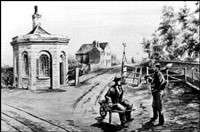 In 1732 an Act of Parliament was passed, allowing the turnpike road from Manchester to Mottram to be constructed. The company contracted to do the work was the Manchester to Saltersbrook Turnpike Trust. They mainly improved the existing road and set up a toll bar in Audenshaw village. In 1824 the new bypass section began which ran across the eastern end of Ashton Moss. The toll bars were used to control crowds threatening to riot during the Plug Riots of 1842. The tolls at Snipe Tavern and Old Audenshaw were manned by 'one gentleman and twelve special constables'.
In 1732 an Act of Parliament was passed, allowing the turnpike road from Manchester to Mottram to be constructed. The company contracted to do the work was the Manchester to Saltersbrook Turnpike Trust. They mainly improved the existing road and set up a toll bar in Audenshaw village. In 1824 the new bypass section began which ran across the eastern end of Ashton Moss. The toll bars were used to control crowds threatening to riot during the Plug Riots of 1842. The tolls at Snipe Tavern and Old Audenshaw were manned by 'one gentleman and twelve special constables'.
Turnpikes declined in the latter part of the 19th century due to competition from canals and railways but the Manchester to Saltersbrook Turnpike Trust appeared to be still in existence in 1884.
Many of the old buildings of Audenshaw were drowned during the construction of three reservoirs from 1877-1882. They were constructed by Manchester Corporation and covered 283 acres. Other old buildings of interest such as Dean Head Farm, built in 1671-2, have since been demolished.
Red Hall and the Red Hall Methodist Chapel were among those buildings drowned by the reservoirs. Red Hall was built in 1672. The estate, which included a large part of the hamlet of Audenshaw, had been given to Captain Ralph Stopford, a captain in Cromwell's army, by Cromwell himself. The Hall passed into the Hobson family. Edward Hobson started a day school in 1740 and, until recently, his charities were used for educational purposes. After his death in 1764, Red Hall passed into the possession of Robert Thornley who built a small factory on the side for furriers and skin dressers. The Thornley brothers were strongly interested in the Methodist revival, and were involved in the building of Red Hall Chapel which was opened on April 21, 1783, near the Hall. It was part of the Stockport Weslyan Circuit, and on April 6, 1786, John Wesley took services at Red Hall when he was 83.
On Audenshaw Road are Priory Cottages - three cottages built in 1793. It is not known for whom the premises were originally built, but it is believed that about 100 years ago they were used as a farmhouse. They were bought during the First World War by Robert Noblett who owned a tanning and leather dressing factory on Audenshaw Road (closed in 1965) for some of his employees. He renovated the cottages, providing toilets, but the original oak beams remained. In the early 1960s they were taken over by Audenshaw Council.
Industrialisation
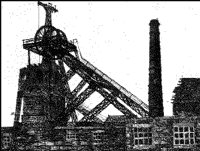 Until the 19th century, Audenshaw was mainly a farming area supplemented by bleaching, hatting and coal mining which continued well into the 20th century. At Hooley Hill, farming gave way to calico printing works during the 19th century, and later a linen factory was established. There was some hatting in Hooley Hill. Butterworth, a local historian, mentions two working hatters in 1823, but during the 19th century the area became a slum and was to be demolished to be rebuilt later.
Until the 19th century, Audenshaw was mainly a farming area supplemented by bleaching, hatting and coal mining which continued well into the 20th century. At Hooley Hill, farming gave way to calico printing works during the 19th century, and later a linen factory was established. There was some hatting in Hooley Hill. Butterworth, a local historian, mentions two working hatters in 1823, but during the 19th century the area became a slum and was to be demolished to be rebuilt later.
Coal mining started in the 18th century, working valuable seams near the surface, and, as these became waterlogged or exhausted, 19th century mining changed to deep seam mining. The Chamber Colliery Mining Company owned three pits; Oak Pit in Oldham, Wood Park Pit in Bardsley and the Ashton Moss Pit, Audenshaw, known as the Snipe Pit. All three worked the famous Roger Seam. The Ashton Moss Colliery opened on May 22, 1880 and tram lines were laid to take coal down to the canal locks. The Chamber Colliery Company had a large number of canal boats in the 1920s to take coal from the Snipe Pit to factories along the canal. The Snipe Pit was one of the deepest at the time. According to the Colliery Guardian in 1892, the shafts went down 952 yards and produced good quality coal. Saltpetre was adapted for gas, domestic use or steam power and coal from the Black Mine seam was well-known locally for producing good gas and domestic coal. The colliery closed in 1959.
James Robertson
James Robertson started factory production in 1864 in Paisley of his Golden Shred marmalade, and built the Manchester factory in 1890 in Audenshaw on the banks of the Ashton Canal. In 1900 the London factory at Catford was built, followed by Bristol in 1914. By 1954 the four factories were employing over 3000 people.
Jones Sewing Machines
 Jones Sewing Machines was founded at Guide Bridge by two brothers, William and John Jones in 1859. William Jones was originally the owner of an engineering firm specialising in very small steam engines for domestic use. After the invention of the sewing machine in the 1840s, he was able to develop special tools to promote large scale production of domestic and industrial machines supplied to clothing manufacturers such as Burtons. The business expanded and in 1889 became a limited liability company. The firm was affected by the Second World War but recovered later in the 20th century. The single story factory stands opposite the original factory completed in 1870.
Jones Sewing Machines was founded at Guide Bridge by two brothers, William and John Jones in 1859. William Jones was originally the owner of an engineering firm specialising in very small steam engines for domestic use. After the invention of the sewing machine in the 1840s, he was able to develop special tools to promote large scale production of domestic and industrial machines supplied to clothing manufacturers such as Burtons. The business expanded and in 1889 became a limited liability company. The firm was affected by the Second World War but recovered later in the 20th century. The single story factory stands opposite the original factory completed in 1870.
The Twentieth Century
By the 1930s engineering and market gardening on Ashton Moss and a variety of light industries were being developed, particularly on the Shepley Industrial Estate. This was originally the site of Shepley Hall which was given by Jane, daughter of Peter de Shepley, to Geoffrey, son of Sir Thomas de Assheton, as a dowry during the reign of Henry VI in the 15th century. The industrial estate which became known as 'Little Trafford Park' was developed after the Second World War by Nathan Brown, who was in light engineering. Audenshaw industrialists moved out of confined city areas to more spacious sites where access to Manchester and other city centres was easily available.
Facts About Audenshaw
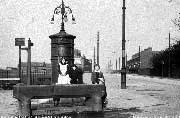

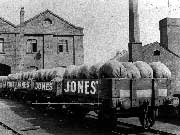
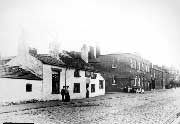
A comprehensive selection of historical photographs can be found at www.tameside.gov.uk/history.
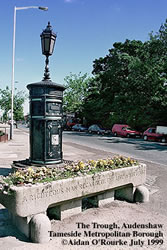 At the traffic lights of Manchester Road and Audenshaw Road stands a transformer which had three lamps to light the way for the trams. Only one of these survives today, at the Trough.
At the traffic lights of Manchester Road and Audenshaw Road stands a transformer which had three lamps to light the way for the trams. Only one of these survives today, at the Trough.
- St Stephen's Church at the corner of Audenshaw Road and Guide Lane, Audenshaw is a Grade II Listed Building. It was built in 1846 in the Early English style, with a spire, at a cost of £2,900 and could seat 750. The chancel was added in 1899 in memory of the Reverend Eager. The vicarage, built in 1889 further along Audenshaw Road, nearer to Stamford Road, is now a nursing home.
- Priory Cottages, Audenshaw Road, Audenshaw. The date stone above the doorway reads 1793. There were three cottages but two have been converted into one. Around 1900 each cottage had four rooms - two bedrooms, a living room and a kitchen. There was no gas or electricity but candles and oil lamps; water came from one cold tap over a stone sink in the kitchen. The 'privy' was outside in the yard.
- Shepley Hall Farm, Shepley Brow, Audenshaw. Shepley Hall was once an elegant mansion with extensive gardens and hothouses. The Shepley family lived there from the fifteenth century until, in the reign of Henry VI, the estate passed by marriage to the Asshetons. In 1821 John Owe bought the estate and it later passed to the Sidebotham family. The estate lay in both Audenshaw and Haughton. Finally a farm was built on the site, but most of the estate has been sold and is now the Shepley Industrial Park.
- Mono Pumps Ltd, Arnfield Works, off Guide Lane, Audenshaw. The works are still operating in the old Guide Bridge ironworks just below Guide Bridge station. Brothers Joseph and Edwin Arnfield moved their engineering works here in 1936. They produced cigarette making machinery for Gallaher until the 1950s. In 1935 Mono Pumps formed to make a new kind of pump. The Arnfields entered into an engineering agreement with Mono, who moved their office to Arnfield Works during the Second World War. Today Mono Pumps is a leader in PC pump manufacturing.
- The opening of Audenshaw Grammar School for Boys, off Stamford Road was 29th July 1932. Mr John Lord was the first headmaster with 300 boys as pupils. The school produced some good rugby players, one of whom, Eric Evans (1930s) captained England. In 1989 the school opted out of local Government control and now has extensions and a sixth form.
Two other local international players were the O'Driscoll brothers. Barry, who played for Ireland in the early 1970's and his younger brother John, who played for Ireland and toured with the British Lions in South Africa and New Zealand in the late 70's and early 80's. Both are doctors who practice in the area. Dr. John O'Driscoll is a British Lions selector for the 2001 Lions Tour.
Mick Hucknall, lead singer of Simply Red, is also a former pupil of Audenshaw School.
- Poplar Street School, Audenshaw was built in 1914 off Guide Lane. It provided secondary education, until, in 1964, the senior pupils were dispersed to local secondary modern schools and Poplar Street retained only the primary section.
- William Jones and his brother John of Jones' Sewing Machine Company LTD, Shepley Street, Audenshaw set up in 1859 producing domestic sewing machines and then heavy industrial ones for Burton's tailors. William originally owned an engineering firm producing very small steam engines for domestic use. In the Second World War they produced machines for making army uniforms and parachutes. In 1968 they merged with the Brother International Group and now also produce machines for knitting and office equipment.
- Audenshaw Lodge barn, Corn Hill Lane Audenshaw is a Grade II Listed Building (North Side). This barn is unique to the area and yet has stood in a dilapidated state for a while. It is on a sandstone plinth with handmade brick walls and a stone flagged roof. The large central door has another doorway opposite on its east side, which suggests its was a threshing barn. Inside are large, hand cut wooden beams supporting the ceiling and there are air vents in the brick walls, so that the corn would keep dry. Arable farming finished very early in this area and signs of ridge and furrow can be seen on parts of the adjacent golf course. As well as the air vents in the brickwork, there is an owl hole at the top. Owls helped to keep vermin away from the corn.
- Eric Evans (1921-91) - Captain of the England Rugby Union team from 1956 to 1958. He was born on Edge Lane in Droylsden and attended Audenshaw Grammar School. He first played for Old Aldwinians RUFC in the late 1930s and during the war joined Sale RUFC. After the was he qualified as a sports master at Loughborough College, later joining Openshaw Technical College in Manchester. Evans was awarded his first England cap in 1948, becoming best known as a hooker. In 1956 he was named England captain and in 1957 led his country to their first Grand Slam since 1928. At the end of the 1957-8 season be retired from international rugby, having been capped 30 times. Under his captaincy England won nine of their thirteen games. He retired from Sale RUFC in the 1962-3 season. He was chairman of Old Aldwinians RUFC from 1957 to 1959 and president from 1960 to 1966.
- Austin Hopkinson (1879-1962) - Local industrialist and inventor, was also a councillor for Audenshaw Urban District Council. Before the First World War he lived in Ryecroft Hall but during that conflict it was used as a hospital and in 1920 he presented this residence to Audenshaw UDC, who used it as the council headquarters. In 1908 Hopkinson invented a revolutionary coal-cutting machine and soon after established a successful company at the Delta Works in Audenshaw to produce these machines.
- Frank Hampson, the creator of famous cartoon character Dan Dare, was born in Audenshaw.
- Harry Norton Schofield was involved in dramatic action in the Boer War for which he was awarded the Victoria Cross. The blue plaque is located at the Ryecroft Hall in Audenshaw.
- John Henry Code was born on 16th February 1869. His blue plaque is located at his former family home, 122 Droylsden Road, Audenshaw.

